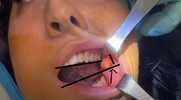PrimalPlasty
Eat Raw Meat and Organs, you slave
- Joined
- Feb 24, 2024
- Messages
- 136
- Reputation
- 242
IM NOT TELLING YOU TO PERFORM SELF-SURGERY!
IM NOT TAKING RESPONSIBILITY.
IM NOT A SURGEON.
YOU ARE THE r****d IF YOU ACTUALLY DO IT.
Some individuals may consider attempting buccal fat removal at home due to factors such as cost concerns, privacy preferences, convenience, desire for control, or lack of access to healthcare, despite the significant risks and potential complications associated with DIY cosmetic procedures.
So anyways:
Make sure that you are following this procedure:
IM NOT TAKING RESPONSIBILITY.
IM NOT A SURGEON.
YOU ARE THE r****d IF YOU ACTUALLY DO IT.
Some individuals may consider attempting buccal fat removal at home due to factors such as cost concerns, privacy preferences, convenience, desire for control, or lack of access to healthcare, despite the significant risks and potential complications associated with DIY cosmetic procedures.
So anyways:
Make sure that you are following this procedure:
- Gathering Equipment: Make sure you have a sharp scalpel or knife, sterilized thoroughly with rubbing alcohol to prevent infection. Additionally, have some local anesthetic (like lidocaine) ready to numb the area, clean gauze, and bandages for post-procedure care.
- Sterilizing the Area: Prioritize cleanliness. Otherwise you'll increase the risk of sepsis, which is deadly even more than it already is. Use rubbing alcohol or another suitable disinfectant to clean the area around your cheeks and mouth where you'll be working.
- Administering Local Anesthetic: This step is crucial for minimizing pain during the procedure. Follow the instructions on the anesthetic packaging carefully, and be sure to apply it to the specific areas inside your mouth where incisions will be made.
- Making Incisions: The targeted area for incisions is inside the mouth, near the back molars. Use caution and precision to create small, precise cuts. Aim to keep the incisions as inconspicuous as possible to minimize scarring.
- Locating Buccal Fat Pads: Once the incisions are made, gently use your fingers to massage the inside of your cheeks to locate the buccal fat pads. These pads are typically located between the cheek muscles and the masseter muscles near the back of the mouth.
- Removing Excess Fat: With the fat pads located, carefully use the scalpel to trim away excess fat. Be conservative in your approach to avoid over-removal, which can lead to a gaunt or overly hollow appearance. It's advisable to start with small amounts and gradually remove more if necessary.
- Stopping Bleeding and Dressing Wounds: After removing the desired amount of fat, apply gentle pressure to the incision sites with clean gauze to stop any bleeding. Then, cover the area with fresh gauze and secure it with bandages to protect the wounds as they heal.
- Post-Procedure Care: Follow your aftercare instructions diligently. This includes keeping the area clean to prevent infection and avoiding activities that could put strain on the incisions. Attend any follow-up appointments as recommended by a medical professional. Visit the hospital immeditately if anything out of order happened!

The Fat is located Under the Upper Teeth and on the buccal mucosa that is on the left and right side, you would want remove the fat on both sides equally so you can keep assymetries minimal.
CAUTION:
Don't go higher than in the picture otherwise you'll risk hitting arteries and loosing alot of blood.
Hope this was somewhat instructive.
WHAT SURGERY SHOULD I COVER NEXT?


